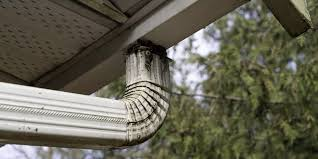What to Do If Your Downspout Is Clogged
A clogged downspout might seem like a small issue—but it can quickly lead to serious water damage. When your downspout isn’t draining properly, rainwater overflows from your gutters and pools around your foundation, potentially causing basement leaks, soil erosion, and structural damage.
In this article, we’ll explain how to tell if your downspout is clogged, what steps you can take to clear it, and when it’s time to call in professional <Gutter & Downspout Services>.
💧 What Is a Downspout and Why Does It Matter?
Your gutter system collects rainwater from your roof. The downspout is the vertical pipe that carries that water from the gutters down to the ground and safely away from your home’s foundation.
If the downspout gets clogged with leaves, twigs, dirt, or even small animal nests, the whole system backs up—leading to overflowing gutters, water damage, and extra pressure on your roof and fascia.
🚨 Signs Your Downspout Is Clogged
Here’s how to tell you might have a blockage:
-
Water overflows from the gutter above the downspout during rain
-
Little or no water comes out of the bottom of the downspout
-
You hear gurgling sounds in the downspout
-
Water pools around your home’s foundation
-
Your basement shows signs of moisture after rain
🧰 How to Unclog Your Downspout: Step-by-Step
If you feel safe using a ladder and the clog isn’t too deep, you can often clear it yourself.
Step 1: Remove the Elbow and Check for Debris
Start by detaching the bottom elbow (the curved section near the ground). This is a common place for clogs. If you see leaves or mud packed inside, remove the debris by hand or with a garden trowel.
Step 2: Flush the Downspout with a Hose
Insert a garden hose into the top of the downspout and turn the water on at full pressure. If the water backs up or doesn’t flow through, you’ve got a blockage higher up.
If the clog is small, the pressure may push it out.
Step 3: Use a Plumber’s Snake or Drain Auger
For stubborn clogs, insert a plumbing snake (or drain auger) into the downspout from either the top or bottom. Push the snake until you feel resistance, twist to break up the clog, and then retract it.
Repeat with water to flush out any remaining debris.
Step 4: Check the Exit Point
Make sure the end of the downspout where water exits isn’t buried, blocked by dirt, or crushed. Extend the downspout at least 3–6 feet away from your foundation with a splash block or extension.
✅ Preventing Future Downspout Clogs
A little maintenance can go a long way:
-
Clean your gutters and downspouts at least twice a year, especially in fall and spring
-
Install gutter guards or downspout screens to catch large debris before it enters
-
Trim trees near your roofline to reduce leaf and twig buildup
-
Flush the system with a hose occasionally during dry seasons
Working with a trusted <Gutter & Downspout Services> provider ensures the system is checked and cleaned professionally—without climbing on ladders yourself.
🛑 When to Call a Professional
If your downspout is:
-
Still clogged after DIY methods
-
Extremely high or hard to access
-
Damaged or cracked
-
Leaking at the seams
Then it’s time to bring in the pros. A qualified Gutter & Downspout Services technician has the tools and experience to clear even the toughest blockages, inspect for hidden damage, and ensure your drainage system is flowing perfectly.
🏠 Why It’s Important to Act Fast
Leaving a clogged downspout alone can lead to:
-
Overflowing gutters and roof leaks
-
Mold and mildew near your walls
-
Erosion of your landscaping or garden beds
-
Foundation cracks or basement flooding
The sooner you fix it, the better.
🔚 Conclusion
A clogged downspout may start as a simple inconvenience, but it can quickly spiral into costly home repairs. By acting quickly, using safe DIY methods, or hiring professional Gutter & Downspout Services, you can restore proper water flow and protect your home from serious damage.
Regular inspections and cleanings are the key to keeping your gutter system flowing freely year-round.

Comments
Post a Comment